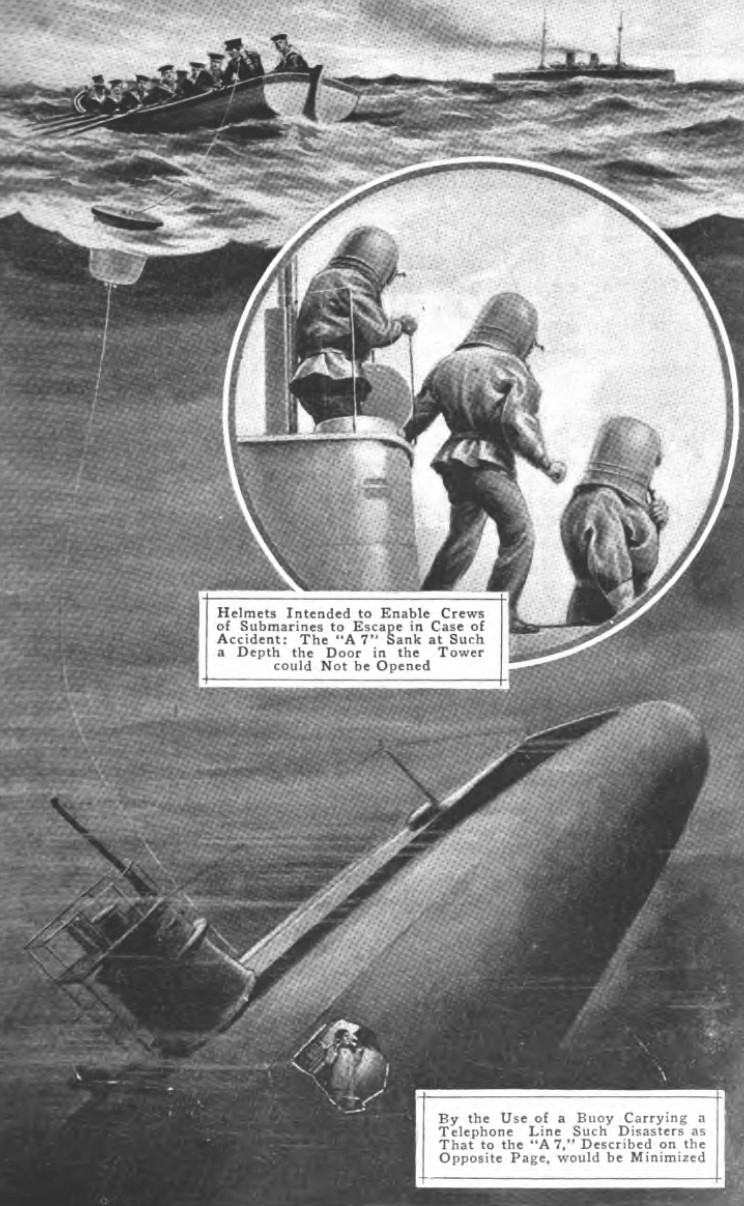|
Around 8 A.M. on Jan. 16, 1914 a submarine flotilla and several ships departed Devonport, England for Whitsand Bay to conduct torpedo attack exercises, the exercise ended with the words "The Secretary of the Admiralty regrets to state that submarine A-7 in the course of exercising today in Whitsand Bay, off Plymouth, failed to come to the surface". She was in company with HMS Pigmy until they entered Whitsand Bay, at which time A-7 submerged to prepare for the mock torpedo attack. By 11 A.M. the men on Pigmy became concerned that A-7 had been submerged to long and attempted to contact the boat, when no contact could be established Pigmy returned to Devonport to report the possible loss of the boat. Before leaving the area a buoy was dropped to mark the spot where A-7 went under in order to make the search easier. When the search vessels arrived on the scene the buoy could not be found making the search far more difficult, up to twenty vessels and even aircraft were ultimately employed in the search, but it was soon realized that the boat was not going to be found quickly and that owing to the fact that there was only enough oxygen in the boat for the crew to survive for six hours at the most, all onboard A-7 were lost. The A class boats were the first class of submarines built by the Royal Navy, A-1 being launched in 1903 and A-7 on Jan. 21, 1905, in all there were thirteen boats in the class. Four of the class had already sunk, the first A-8 sank on June 8, 1905, exactly one month to the day after she was commissioned. It was determined later that loose rivets in the bow allowed water to enter the boat. The second to go to the bottom was A-4, she sank on Oct. 16, 1905 after water came through an open vent, the boat managed to surface and the crew escaped, but she sank after an explosion while being towed to port. The other two boats to sink, A-3 (Feb. 2, 1912) and A-1 (Mar. 18, 1914) were both lost to collisions. At the time what happened to A-7 was unknown. Within a couple of days the news had reached around the world and messages of condolence arrived at the Admiralty, King Haakon of Norway, French President
Raymond Poincaré were among those who sent their sympathies along with the same from Austria, Chile, Russia, Japan, Italy, Sweden and the U.S.A. Considering the fact that at that in a few months German submarines would be stalking British ships the most interesting message came from Grossadmiral Alfred von Tirpitz, it read as follows; However with all the political pleasantries aside, A-7 had still not been found and the search continued. On the morning of Jan. 20 Commander Douglas W. Hamilton-Gordon, the commanding officer of HMS Thrasher and the man in charge of the torpedo boats searching for A-7, was found dead in his bunk in Thrasher, it was determined he died from a combination of heart disease and pneumonia which was probably brought on during the search. In a strange twist of fate his grandmother, Lady Ellen Hamilton-Gordon died two days later. The day after his death, Jan. 21, HMS Pigmy found oil on the surface and a diver sent down soon confirmed that the oil was coming from A-7, the wreck had been found. She was in a strange position, her stern dug in to the sea floor over 20' and the bows up at a 30° to 40° angle and she lay over 130' below the surface. Salvage attempts were continuously made until early March when the Admiralty finally abandoned the effort. |
© 2010 Michael W. Pocock MaritimeQuest.com |
 |
April 1914 image from Popular Mechanics magazine showing the wreck of HMS A-7.
|
2005 Daily Event |
||